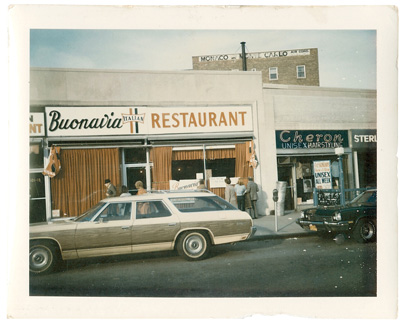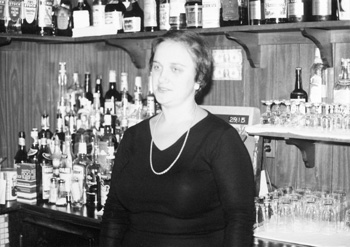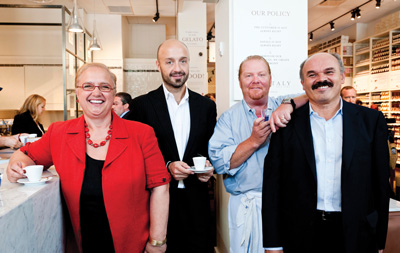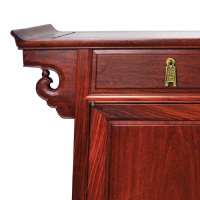Can a living institution be described in one word? In the case of Lidia Bastianich—chef, author, teacher, TV personality—it is especially difficult given the multiplicity of her achievements. But if a single word had to be chosen, it would be restaurateur, which characterizes her first professional foray into food and the venue from which she propelled herself into worldwide stardom.
“Science was my interest. My husband was in restaurants and wanted to open one,” she says. That was actually a natural progression for a woman who has a personal and emotional attachment to food. “I was always around food. My grandmother was a great cook who involved me. We would slaughter a pig and make everything from blood sausages to regular sausages. We picked potatoes. She’d pick big ones and I’d dig for the little ones; they were still warm from the earth,” recalls Bastianich, her eyes twinkling. “All of that had an effect on who I am. When I came to America I missed that. Food became my connection, my umbilical cord to love and culture. Cooking brought Grandma back, too, so it was very nostalgic. It became my medium of expression.”

Buonavia was Lidia’s first restaurant, located in Forest Hills, NY; the restaurant opened in 1971.
The Bastianichs’ first restaurant, Buonavia, led to a second, Villa Secondo, both in Queens. When the couple realized that many customers were coming from Manhattan, they took the brave, frightening step of liquidating resources, including the two restaurants, to open Felidia on the East Side. Ever the businesswoman, Bastianich realized that the move would give them the “security of real estate. It was tough—we almost didn’t make it.”
At this point, we have to set the stage of the food world in 1971; it was definitely not the foodie-crazed environment of organic/non-GMO/hyper-authentic-or-fanciful-fusion that we have today. True, Julia Child had already launched a revolution with her television show and classic text Mastering the Art of French Cooking.
But down in the kitchens of America, fondues and crockpot stews were the craze, displacing the heavily processed ingredients in TV dinners and marshmallow-gelatin desserts.

Lidia at her first restaurant, Buonavia, in Forest Hills, Queens
Italian food as generally served in restaurants was predominantly from southern Italy: pizza, or an interpretation of veal Parmigiano, or almost anything with garlic and tomato sauce. Northern Italian cuisine, found above the “butter belt,” was creams/white sauces, polentas and rice, and was not as prevalent here as southern. They all leaned heavily to American interpretations in any case, as immigrants learned to utilize the foods they found here. Even if somebody wanted to cook authentically, it was difficult; prosciutto, for example, couldn’t be imported, and Carnaroli rice, which Bastianich favors for risottos, was virtually nonexistent here.
“I would go to Italy, look around and bring things back that I asked importers to bring in,” states Bastianich. It wasn’t easy. Nevertheless, she decided to formulate menus for Felidia based on the regional cooking she did at home; the word got out, resulting in tremendous curiosity about her food.
“When we opened the doors people were lined up,” she recalls. “The newspaper journalists came. All the chefs, even James Beard and Child [who became a friend and to whom Bastianich’s new book, Mastering the Art of Italian Cuisine, is a tribute] came to check it out. That’s when I became Lidia Bastianich.” Television shows, books, and fame followed. So did more restaurants, especially after her son Joe came aboard. “He put everything together for Becco,” she says. “Joe met Mario [Batali, whom Bastianich dubs one of her boys], and Babbo developed.” Daughter Tanya is also at the top of the company, having developed tours of Italy as her entry point into the family business.
The jump out of New York City was to Kansas City in 1998, followed three years later to Pittsburgh; both restaurants were in questionable economic zones. And here we have to set the stage again, this time with a view of the Strip in 2001, before today’s near-carnival atmosphere.
“The Strip had became dead in 2001; it was grungy. There had been a number of closings. Some old-timers were still there, but nobody was doing a whole lot,” recalls Joe Hermanowski, founder of the wholesale candy company on Penn Avenue. “Some of the remaining merchants thought ‘Wow! She’s really putting herself on the line opening an upscale restaurant.’” That decision just ratifies Bastianich’s business acumen.
All her restaurants reflect Bastianich’s philosophy of fresh, seasonal, authentic food well prepared, but menus aren’t cookie cutter. “There are similarities in the menus across our restaurants. The chefs collaborate; we don’t dictate. It’s all pulled together with everybody’s talent,” Bastianich says proudly. There are no suburban restaurants and no franchises—not that they wouldn’t be welcomed, as Italian food is wildly popular.
“It just makes sense,” Bastianich declares. “The food is pleasurable. It’s not hard to cook. There’s a lot of information on Italian food. So I think it’s a self-fulfilling prophecy” that the food is so well accepted.

Lidia, her son Joe Bastianich, Mario Batali, and Oscar Farinetti are co-owners of Eataly, the artisanal Italian marketplace with locations in New York, Chicago, and elsewhere.
Further testimony to that is Eataly, a gastronomic emporium of Italian restaurants, products, and a school under one roof. The concept is based on a European chain that started in Turin. Says Bastianich of her visit to the flagship store: “I talked with the owner. He thought the concept would work in New York.” It did. In addition to the original Eataly on Fifth Avenue, and the current ones in São Paulo and Chicago, plans are underway to open in the World Trade Center, Boston, and Los Angeles.
Nowadays Bastianich enjoys traveling with her children and grandchildren, resulting in a new relationship to the business as the baton is passed firmly to the next generation. “I do whatever my children need from me. I don’t want to take the responsibility. I want to enjoy what I have.”
Nevertheless, she remains the face of a well-known, well-respected brand that has been in the forefront of educating American palates to the best in all tastes Italian.
[follow_me]





